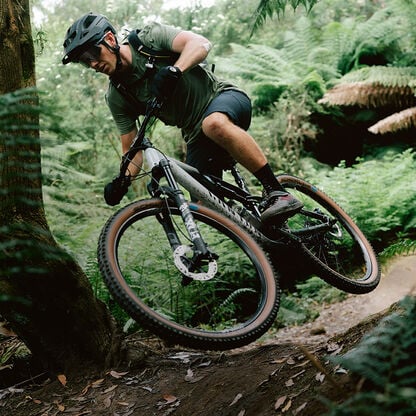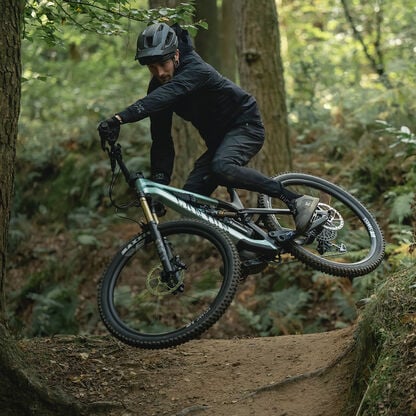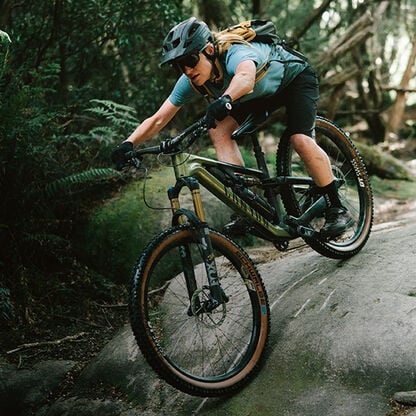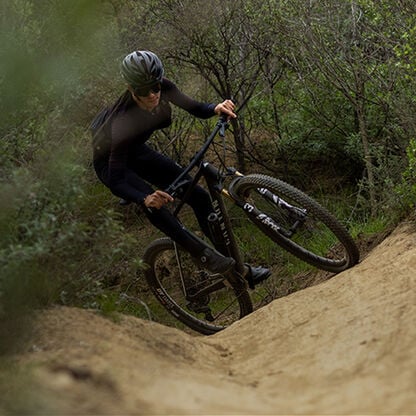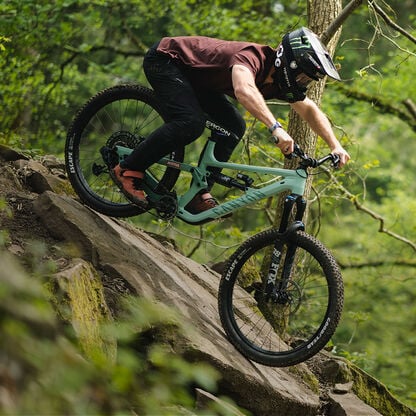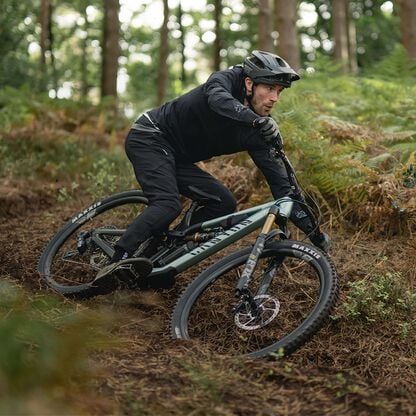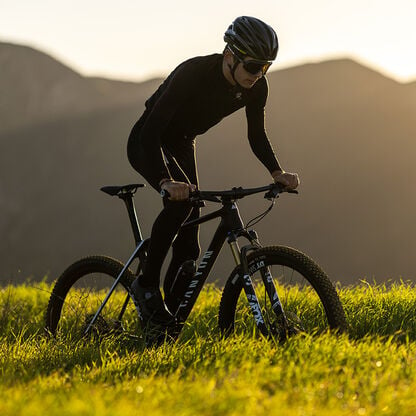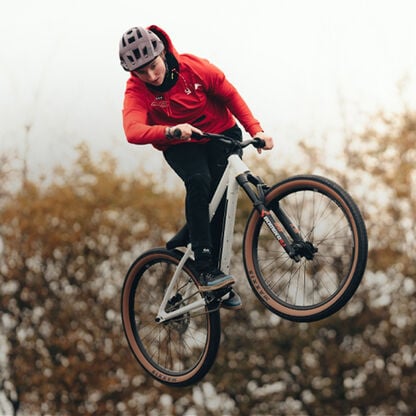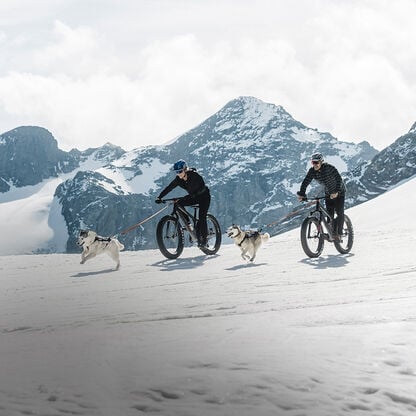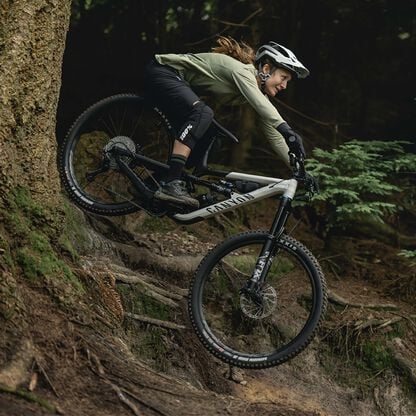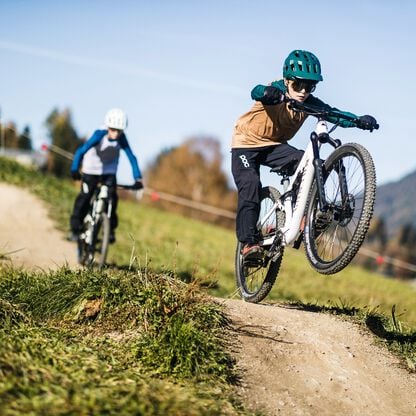Enduro vs trail bike: Which one is right for you?
Spotting the differences between enduro vs trail bikes can be tricky to the untrained eye. In this guide, we share everything you need to know about the both.
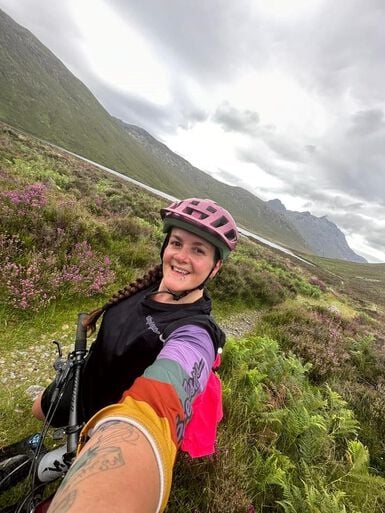

The trail bike is the broadest of mountain bike categories and more versatile than enduro across a wider range of terrain. It’s this versatility that can sometimes cause confusion over which bike is best, when subtle changes in geometry can make such a huge impact on how the bike rides.
Both mountain bike types can climb, both can descend, both love a bit of flow, so how do you choose between enduro vs trail?
Let’s dive into the detail to help you decide…
Contents
What is a trail bike vs enduro bike?
Before getting into the nuances of trail vs enduro mountain bike geometry, let’s define the two.
A trail mountain bike is a fun all-rounder in the mountain bike world – the jack of all trades and master of many, comfy enough to soak up hours of flow on fast, tight, technical trails. As a rule, the trail bike will be lighter, shorter, more responsive and agile than its bigger, heavier enduro counterpart, with maximum climbing and pedalling efficiency for big days in the saddle. Trail bikes are closer to cross-country (XC) bikes on the mtb spectrum, but with bigger front and rear suspension for a bouncier, more responsive ride.
The enduro mountain bike sits on the other end of the scale, towards downhill bike. Originally designed for enduro racing, and able to munch up the roughest, steepest descents at speed, but with just enough pedal efficiency to power back up to the top.
The differences in trail vs enduro bike geometry lean towards their respective ends of the mtb spectrum – enduro towards downhill, for maximum rough trail capability, and trail towards XC, for greater efficiency on mixed terrain.
Enduro bikes are predominantly built for downhill so have a longer wheelbase, longer reach and slacker head tube angle than trail bikes (around 63-4º vs 66º). This levels out rider position to feel more planted on steep descents, and slows steering for better stability at speed. Bigger hits demand stronger brakes, so larger rotors and more powerful pads on enduro bikes compared with trail bring greater stopping power in all conditions.
Trail bikes have a shorter reach, shorter wheelbase and steeper head angle so are more agile and easier to throw around for twisty, techy singletrack climbs and long days in the saddle. Bigger travel trail bikes can still handle a rough descent, but might feel a bit underbiked on the steepest, gnarliest trails due to the steeper angle at the front.
Enduro bikes typically have a steeper seat tube than trail bikes (76º vs 78º) to position the rider more forward for better control on steeper climbs as per the terrain in enduro racing. The Neuron trail adventure bike has a slightly slacker seat tube for mellower climbs and long rides with a more even weight distribution over the bike.
Some bikes have adjustable geometry for the best of both worlds. The Strive’s Shapeshifter technology enables the rider to shift between two geometries mid-ride. Shred mode slackens the head angle and lengthens the wheelbase for maximum downhill performance; and Pedal mode steepens seat and head angles by 1.5º, raises bottom bracket height and locks out rear travel to 140mm for better climbing efficiency.
Let’s zoom in on some of the numbers:
Enduro:
Strive - our race-winning enduro bike:
- 170mm front and 160mm rear suspension
- 63º head angle
- 76.5º seat angle
- 475 reach (M)
- 1262mm wheelbase
- Disc brake size 200mm
Torque - gravity all-rounder (enduro):
- 170mm front and rear suspension
- 63.5º head angle
- 77.5º seat angle
- 465mm reach (M)
- 1253mm wheelbase
- Disc brake size 220 / 203mm
Trail:
Spectral - versatile trail-slayer:
- 150mm front and 140mm rear suspension
- 64º head angle
- 76.5º seat angle
- 456mm reach (M)
- 1251mm wheelbase
- Disc brake size 203mm
Neuron - lightweight trail adventurer:
- 140mm front and 130mm rear suspension
- 66º head angle
- 76º seat angle
- 455mm reach (M)
- 1203mm wheelbase
- Disc brake size 180mm
Learn more about mountain bike geometry in this beginner’s guide.

Suspension and travel: Right setup for your ride
Trail bikes typically have less front and rear travel than enduro bikes, but the range in suspension is wider due to their versatility. Trail bikes average between 130-160mm front suspension, and up to 150mm in the rear, vs 160-180mm front and 160-170mm rear for enduro.
Air-sprung rear shocks are the most popular in many trail and enduro bikes, but some harder-hitting enduro bikes, like the Torque, have coil rear shocks which bring better rear-wheel traction to keep your bike more glued to the ground in rough terrain.
Coil shocks are only compatible with some bike frames depending on the suspension kinematics. They’re more resistant to heat that can build up on long descents and require less maintenance but are heavier and harder to adjust to suit your weight, while air shocks can be easily tuned for any rider weight using a shock pump.
The fork size on enduro vs trail bikes also vary. Forks on a trail bike are a minimum of 34mm stanchions and up to 36mm which is stiffer. Enduro bike forks are a minimum of 36mm rising to 38mm, for a stiffer, more durable and controllable ride on the rough stuff.
How to set your sag with an air shock
Whether you’re riding enduro or trail, it’s important to set your suspension up correctly for your weight. This is done by adjusting the sag on the fork and shock. Sag is the measurement of how soft or hard your suspension is, and how much it moves when you put your weight on the bike.
If your sag is too hard (i.e. too much air in your fork or shock), the bike will feel rigid and bounce off obstacles, and if it’s too soft (not enough air) it’ll feel sluggish and sink into every dip and sapping more energy to ride. Setting your suspension correctly to your weight will make sure it comfortably soaks up the bumps in the trail without bottoming out all the time, for a balanced and controlled ride.
Trail bikes should typically be at around 20-25% sag, while enduro bikes need a bit more, at 30-35%. The position of the rubber o-rings on the rear shock and fork stanchion when you’re sat on the bike indicates sag.
Rear:
- Slide the o-ring up to the top of the shock shaft, against the seals.
- Sit on your bike with full weight on the pedals - try not to bounce. You might need to hold the wall or get a friend to help. It’s a good idea to wear all of your riding gear when setting up your sag for accurate bodyweight on the bike.
- Step off the bike and check the position of the o-ring.
- If it’s moved more than 20-25 or 30-35%, add air with a shock pump and re-test. If it’s not moved enough, take air out.
Front:
- Slide the o-ring to the bottom of the fork stanchion against the seals.
- Get on the bike and stand on the pedals in an aggressive position, leaning on the bars for a more accurate weight distribution. You can do this balancing next to a wall or riding along in a carpark.
- Step off the bike carefully and check the position of the o-ring. Add / remove air and retest as needed.
Top tip: If you don’t have an o-ring on your shocks use a loose cable tie but don’t forget to remove it after you’ve set your sag up.
Frame material matters: Breaking down the options
Trail and enduro bike frames are most commonly made of either carbon fibre or aluminium, with carbon being the more expensive option. It’s lighter and has more torsional stiffness, dampening the trail to feel a bit smoother on your hands and through the seat when riding compared to aluminium mountain bikes.
This dampening effect also soaks up repeated impact over time as the material springs back into place, vs aluminium which eventually fatigues after repeated impact and is not repairable like carbon. For this reason, carbon usually has a longer lifespan than aluminium but with either it all depends on how well you look after your carbon mountain bike and how hard you crash, if at all.
Weight saving is usually a key reason that many riders choose a carbon trail or enduro bike, but that doesn’t make aluminium obsolete. The Spectral AL is only 400-500g heavier than the CF and both go through the same rigorous stress testing to match performance as close as possible.
If a seamless design and smooth aesthetic matters to you, the weldless design of carbon will be attractive. But if you’re on a budget, aluminium is affordable, robust and durable, still guaranteed to deliver miles of smiles on the trails.
Read more on whether you should buy a carbon vs aluminium mtb.

Wheel size and tyre considerations: Finding the perfect fit
MTB wheel sizes have grown in recent years and nowadays, most trail and enduro mountain bikes are equipped with 27.5 or 29 inch wheels.
There are pros and cons for each wheel size and set up. Shorter riders on small frame sizes will be best suited to 27.5 inch wheels for best manoeuvrability. 27.5 wheels are more nimble and playful than 29ers, so you can throw the bike around and accelerate quicker but need to pedal more to stay up to speed. One downside of smaller wheels is it’s harder on loose rocky trails due to the steeper attack angle.
With 29 inch wheels, bigger = better rollover on rough terrain, increased stability and traction, and easier to maintain speed. They need bigger tyres so add height to the bike which further reduces the chance of pedal strike.
If you want the best of both worlds, you can mix the two for a mullet set up, which is 29 on the front and 27.5 on the back, offering the best of speed, traction, rollover and playful agility.
Read more on how to choose your perfect wheel size.
Enduro vs trail bike tyres
When it comes to tyres, there’s a fine balance between grip and rolling speed. For enduro, maximum traction is key, to give confidence and predictability on the roughest tech descents.
Enduro tyres tend to be thicker, with deeper, contrasting tread and thicker casings to prevent punctures. This is great for grip, but the compromise here is in weight and rolling efficiency, so they’ll feel heavier and slower on the flats or climbs than a lighter trail bike tyre.
For trail bike tyres there’s a range of tyres to suit different riding types and conditions across the wider spectrum. If most of your riding is bike park laps on reds and blacks, decent grip with side tread for maximum traction in berms and rocks or roots in the wet is key.
For a big day in the saddle with a mix of techy climbs and loose, natural descents, a lighter tyre that balances grip and rolling efficiency might be best.
Whichever tyres you choose, staying rubber side down is always the goal! Your guide to mountain bike tyre pressure.
Gearing up: Drivetrain and gearing
The latest trail and enduro bikes come equipped with a 1x12 drivetrain, which is a single front chainring attached to the crankset and no front derailleur. Along with saving weight, this simplifies shifting and reduces clatter on the two or three front chainrings that mountain bikes have had over the years.
A larger 12-speed cassette on the back (aka ‘dinner plate’) compensates for the loss of the front derailleur and wider gear range that a 2x set up brings.
Crank lengths are customisable to suit the rider height, and the priorities are different for enduro vs trail bike riding. Trail bikes need strong pedal efficiency so cranks can be up to 170-175mm, whereas for enduro the priority is ground clearance with more suspension and sag, so cranks can be as short as 160mm.
Learn more about the right mtb groupset for your needs.

Bottom bracket height: Impact on performance and handling
The height of the bottom bracket (BB) affects how stable or responsive the bike handles. Typically, an enduro bike will have a higher BB than a trail bike, due to the increased suspension on the front and rear and need to get over the big stuff without pedal strike. On a trail bike the lower BB helps with cornering and carving out turns, inspiring more confidence at speed on the trails.
Evaluating kits and the role of dropper posts
Anything that’s not the frame, forks, wheels or drivetrain is the finishing kit, and this includes contact points like the handlebars, grips and saddle. Finishing kits for trail and enduro bikes are similar, including wide handlebars, though enduro bikes are usually wider (Neuron: 760mm vs Spectral: 780mm vs Torque 800mm).
And dropper posts – once you’ve had one on your mountain bike, you won’t go back.
A dropper is an adjustable seat post that moves up and down at the press of a switch on the handlebars. For trail riding it’s pretty essential if you want to keep your flow on the ups and downs, otherwise you’d have to stop and adjust your seat for every climb or descent.
Top tip: Say no to mid-trail seat faff. Adjust the top saddle height of your dropper post when you first get your bike to make sure it’s in the right position for you to pedal efficiently.
Enduro or trail bike? How to make the right choice
If you’ve read this far, the decision between an enduro or trail bike should hopefully feel a bit clearer. It all comes down to the type of riding you want to mostly do.
If you want a bike that can handle the demands of enduro racing, or if you’re a hard-hitting progressive trail rider looking for a mix of trail bike versatility and capability for the toughest trails, with occasional bikepark use - an enduro bike is best (explore our enduro mountain bike buyer’s guide.)
If you’re not racing and are mostly hitting the trails with friends, out on big natural rides and bike park laps, a trail bike is the one (check out our trail mountain bike buyer’s guide.)
Which trail bike to choose depends on how far up or down the XC-Enduro trail bike spectrum you go.
Discover our Mountain Bikes
Did this article help?
Thank you for your feedback
-
 About the author
About the authorTess Agnew
Tess is a freelance copywriter, social media and communications pro based in Brighton with a passion for the outdoors and the mental health benefits it brings.
